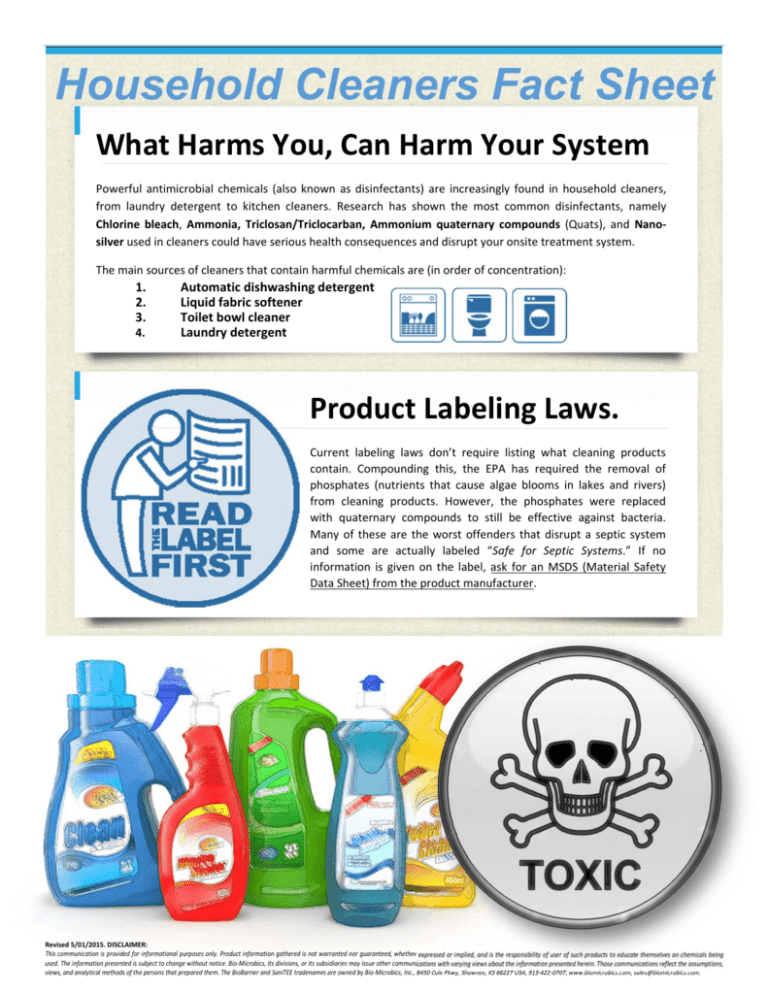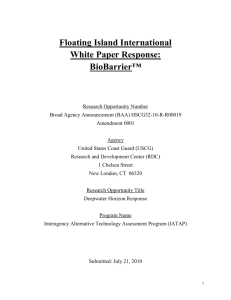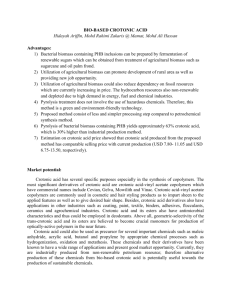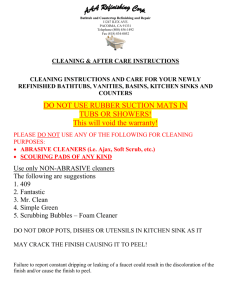BioBarrier® User Information & Cleaner Usage Brochure
advertisement

Household Cleaners Fact Sheet What Harms You, Can Harm Your System Powerful antimicrobial chemicals (also known as disinfectants) are increasingly found in household cleaners, from laundry detergent to kitchen cleaners. Research has shown the most common disinfectants, namely Chlorine bleach, Ammonia, Triclosan/Triclocarban, Ammonium quaternary compounds (Quats), and Nano‐ silver used in cleaners could have serious health consequences and disrupt your onsite treatment system. The main sources of cleaners that contain harmful chemicals are (in order of concentration): 1. 2. 3. 4. Automatic dishwashing detergent Liquid fabric softener Toilet bowl cleaner Laundry detergent Product Labeling Laws. Current labeling laws don’t require listing what cleaning products contain. Compounding this, the EPA has required the removal of phosphates (nutrients that cause algae blooms in lakes and rivers) from cleaning products. However, the phosphates were replaced with quaternary compounds to still be effective against bacteria. Many of these are the worst offenders that disrupt a septic system and some are actually labeled “Safe for Septic Systems.” If no information is given on the label, ask for an MSDS (Material Safety Data Sheet) from the product manufacturer. Revised 5/01/2015. DISCLAIMER: This communication is provided for informational purposes only. Product information gathered is not warranted nor guaranteed, whether expressed or implied, and is the responsibility of user of such products to educate themselves on chemicals being used. The information presented is subject to change without notice. Bio‐Microbics, its divisions, or its subsidiaries may issue other communications with varying views about the information presented herein. Those communications reflect the assumptions, views, and analytical methods of the persons that prepared them. The BioBarrier and SaniTEE tradenames are owned by Bio‐Microbics, Inc., 8450 Cole Pkwy, Shawnee, KS 66227 USA, 913‐422‐0707, www.biomicrobics.com, sales@biomicrobics.com. BioBarrier® User Information & Cleaner Usage This information will help you understand your system and give some simple tips that may help to have a long and trouble‐free operating life from your system. The BioBarrier® MBR is a water recycling system, not a septic system. In the simplest of terms, the BioBarrier removes virtually all of the pollution from the water that you use. You put the water back the way you found it. The BioBarrier does this in three simple steps. 1. The “trash tank” separates waste by specific gravity and then the SaniTEE® filters out solids that could damage the BioBarrier membrane. 2. Aerobic bacteria in the BioBarrier tank supported by air from the blower ingest the soluble organic pollution from the water, growing and multiplying forming colonies of organisms. This is known as biomass. A healthy biomass needs food, oxygen, and an environment with as few toxic chemicals as possible. The BioBarrier is engineered so the limiting factor is the food source and the biomass is kept hungry consuming all of the available food which are the soluble organic compounds in the water. 3. The membrane filter then separates the clean water from the biomass concentrating it in the tank. 4. After the water passes through the membrane which has pore sizes between 0.3 and 1.0 microns, smaller than any bacteria and most viruses it is safe to use for nonpotable recycled applications. The problem with toxic inhibition of the biomass is universal and has grown to massive proportions in the last four years because of the EPA requirement to remove phosphates from cleaning products. Phosphates are fertilizers that caused algae blooms in lakes and rivers. The cleaning products industry had to replace the phosphates they removed to clean clothes, floors, and dishes, and unfortunately the cheapest replacement was a class of chemicals known as “Quaternary Ammonium Cations,” or “Quats” for short. The EPA deadline to replace phosphates was July 1, 2010. Compounding this are product labeling laws requiring less information on what these cleaning agents contain. Also, there are so many compounds in the Quat class of chemicals that all but professional chemists would be lost. Many of the worst offenders are actually labeled “Safe for Septic Systems.” A sudden influx of ANY toxic compounds affects ALL biological systems. This affects even large municipal sewer treatment plants, but in onsite systems the concentration changes far more rapidly killing biomass because of the lack of volume of water to mitigate the problem. The main sources of Quats in common household products are (in order of concentration): 1. Automatic dishwashing detergent 2. Liquid fabric softener 3. Toilet bowl cleaner 4. Laundry detergent There are other sources of Quats like pre-moistened disinfecting wipes, and pre-loaded cleaning sponges. These can simply be disposed of in the trash and not flushed. There are cleaning agents in all of these classes of products that are free of Quats and will not inhibit biomass growth. Some are easy to find even without knowing the chemical names. In laundry detergent for example if the label says it contains Cationic Surfactants then it contains Quats and shouldn’t be used. If the label says it contains Anionic or Non-ionic Surfactants then that product is generally safe to use in any onsite system including the BioBarrier. Your BioBarrier dealer has QAC test strips that will show if the cleaning products you use contain Quats or not and if you will need to change to a different brand of a particular cleaning agent. Doing this is important, no matter what type of onsite system you have. All systems use aerobic biological treatment as part of the process. Even a simple septic tank and field. Killing the aerobic bacteria will significantly shorten the life of the system and unlike the BioBarrier, you won’t know until it’s too late. If you are replacing a failed onsite system then it is even more important to track down what cleaning products you use containing Quats before you install a new replacement system. Finding what caused the existing system to fail is imperative before you replace it. The Bio-Microbics dealer can help you solve the reason the last system failed before it’s replaced. Understanding how the BioBarrier works will help you keep it trouble free. And, if an alarm occurs let you know the cause. Some things you can correct. Others are mechanical and will require the BioBarrier dealer to service. High water alarm: The water passes through the membrane at a very slow rate. Ideally about 0.5 gallons per minute. The BioBarrier tank is sized with enough room for you to use water as you normally do while the membrane filters at its slow but constant rate. The two main reasons to have a high water alarm is either too much water is being used, generally from a leaking toilet or faucet, or the membrane has fouled to the point where it needs to be cleaned. Before you call the dealer, check the fixtures. Mechanical failure: The computer control system of the BioBarrier records all events just like new cars. The dealer will download this information when they service the unit and not only see what is wrong now, but be able to predict upcoming service so you will not be inconvenienced by unexpected outages. Membrane fouling: The BioBarrier is a true water recycling system that has a computer control and numerous sensors to make sure that water that has been processed is safe for direct human contact or if there is a problem the system stops filtering. This is the second reason to have a high level alarm. The main cause of this are the pores of the membrane have plugged with soluble organics or inorganic compounds that should have been ingested by the biomass but were not because the biomass has been compromised by toxic chemicals. Toxic chemicals distressing the biomass not only affects the BioBarrier but every type of biological treatment system. The difference is that because of the filter, the BioBarrier will be affected sooner, and is also easier to remedy. Please understand that membrane fouling due to soluble organics or inorganic compounds is not part of normal service and the Dealer will charge for this service over and above any normal service fee. For questions or concerns about your system, please contact the Bio-Microbics Distributor for Illinois. Bio-Microbics Illinois provides wastewater treatment plants for residential and commercial properties: Kurt Bihler, Owner, BihlerTech Inc, www.biomicrobicsillinois.com, Ph: 815-714-8505 Revised 5/01/2015. DISCLAIMER: This communication is provided for informational purposes only. Product information gathered is not warranted nor guaranteed, whether expressed or implied, and is the responsibility of user of such products to educate themselves on chemicals being used. The information presented is subject to change without notice. Bio‐Microbics, its divisions, or its subsidiaries may issue other communications with varying views about the information presented herein. Those communications reflect the assumptions, views, and analytical methods of the persons that prepared them. The BioBarrier and SaniTEE tradenames are owned by Bio‐Microbics, Inc., 8450 Cole Pkwy, Shawnee, KS 66227 USA, 913‐422‐0707, www.biomicrobics.com, sales@biomicrobics.com.






